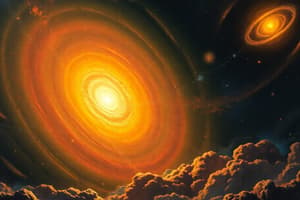Podcast
Questions and Answers
What is the source of pressure that stops the crush of gravity of a white dwarf?
What is the source of pressure that stops the crush of gravity of a white dwarf?
- neutron star
- white dwarf (correct)
- black hole
- terrestrial planet
Why won't our Sun ever become a white dwarf supernova?
Why won't our Sun ever become a white dwarf supernova?
- Our Sun will not become a white dwarf.
- Our Sun is not massive enough for a white dwarf supernova to occur. (correct)
- Our Sun is not in a close binary system.
- Our Sun is only massive enough for novae to occur.
If we could see the Milky Way from 2 million light-years away, how would it appear?
If we could see the Milky Way from 2 million light-years away, how would it appear?
- like a single dim star.
- to fill the sky with widely spaced stars.
- as a faintly glowing, long band of light. (correct)
- to be a disk with spiral arms.
What are most stars in the Milky Way's halo?
What are most stars in the Milky Way's halo?
What is the primary reason for a protostar to be enshrouded in gas and dust in its early stages?
What is the primary reason for a protostar to be enshrouded in gas and dust in its early stages?
During which stages does a protostar generate bright infrared light?
During which stages does a protostar generate bright infrared light?
What marks the transition of a forming star into a main-sequence star?
What marks the transition of a forming star into a main-sequence star?
What occurs during the red giant phase of a low-mass star's life?
What occurs during the red giant phase of a low-mass star's life?
What is the primary cause of the periodic appearance and disappearance of a neutron star when observed from Earth?
What is the primary cause of the periodic appearance and disappearance of a neutron star when observed from Earth?
How were neutron stars first observed?
How were neutron stars first observed?
What distinguishes a neutron star in a close binary system that forms dense, hot accretion disks?
What distinguishes a neutron star in a close binary system that forms dense, hot accretion disks?
What process can lead to the emission of X-ray bursts on the surface of a neutron star in a close binary system?
What process can lead to the emission of X-ray bursts on the surface of a neutron star in a close binary system?
What triggers the ignition of nuclear fusion in a white dwarf supernova (Type Ia)?
What triggers the ignition of nuclear fusion in a white dwarf supernova (Type Ia)?
Why are white dwarf supernovae (Type Ia) useful for measuring large distances in the universe?
Why are white dwarf supernovae (Type Ia) useful for measuring large distances in the universe?
What is the nature of a neutron star created by the collapse of the iron core in a massive star supernova?
What is the nature of a neutron star created by the collapse of the iron core in a massive star supernova?
What distinguishes a pulsar from a regular neutron star?
What distinguishes a pulsar from a regular neutron star?
Flashcards are hidden until you start studying
Study Notes
White Dwarfs
- Electron degeneracy pressure is the source that stops the crush of gravity in a white dwarf.
- Our Sun is not massive enough to become a white dwarf supernova, as it will not accumulate enough material in its core to reach the critical mass.
The Milky Way
- If viewed from 2 million light-years away, the Milky Way would appear as a barred spiral galaxy.
- Most stars in the Milky Way's halo are old, low-mass, and metal-poor.
Protostars
- Protostars are enshrouded in gas and dust in their early stages primarily to conserve angular momentum.
- A protostar generates bright infrared light during the main accretion and protostellar outburst stages.
Star Life Cycle
- The transition from a protostar to a main-sequence star is marked by the establishment of hydrostatic equilibrium.
- During the red giant phase of a low-mass star's life, the star expands to about 10-100 times its original size, and its surface temperature cools.
Neutron Stars
- The periodic appearance and disappearance of a neutron star when observed from Earth is primarily caused by its rotation and beam-like emission.
- Neutron stars were first observed as pulsars, emitting electromagnetic radiation in a beam.
- A neutron star in a close binary system that forms dense, hot accretion disks is distinguished by its X-ray emission.
- The process that can lead to the emission of X-ray bursts on the surface of a neutron star in a close binary system is thermonuclear runaway.
Supernovae
- The ignition of nuclear fusion in a white dwarf supernova (Type Ia) is triggered by the accumulation of material from a companion star.
- White dwarf supernovae (Type Ia) are useful for measuring large distances in the universe because of their consistent maximum brightness.
Neutron Star Formation
- A neutron star created by the collapse of the iron core in a massive star supernova is extremely dense and has a strong magnetic field.
- A pulsar is distinguished from a regular neutron star by its beams of electromagnetic radiation that sweep through space as it rotates.
Studying That Suits You
Use AI to generate personalized quizzes and flashcards to suit your learning preferences.





